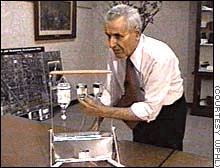
For a variety of reasons, passive euthanasia is the only form that should be allowed. I base my opinion on the opinions of doctors and other Americans. In the United States from a survey of 3,702 doctors taken in April of 1998 only 11% of them would Ok active euthanasia. Only 7% of doctors would provide lethal injection if asked to do so and only 6% say that they have ever done either (Rubin 1A). However, the American Medical Association feels that the legislation of passive euthanasia is unnecessary. This opinion is based on the fact that people die everyday who are on life support and that attempts are failing daily to bring back life (Horkan 70-71). While I do not agree with the sixty percent of Americans who support active euthanasia, I do agree with the eighty percent that support passive euthanasia (Humphry 186). Obviously there is strong support for my opinion.
I oppose the two primary methods of active euthanasia: lethal injection and the withholding of food and fluids. I feel that the life of any person should be appreciated and lived out until he or she needs the use of life-support machines. By administering a lethal injection, one causes the patient to cut his life short. Withholding food and fluids not only shortens the life, but it causes additional days of great suffering. Some of the effects are nausea, vomiting, muscle pain, cough, and shortness of breath (Harris 5).
I support passive methods of euthanasia. The two primary methods are removal of life support and removal of necessary medicines. Employing life support and medicines would lead to an unnatural prolonging of life. Removing them does not shorten life, does not place the patient’s family in unnecessary debt, and also does not cause prolonged suffering for the patient or for the patient’s family.
A reasonable approach to the question of euthanasia involves four considerations. First, one should decide that the circumstances are appropriate. Is the patient on life-support? Is the patient elderly? Does the family believe in euthanasia? Is the patient suffering terribly? Is the patient mentally capable of participating in this decision? If the answer to two of these questions if “no,” then euthanasia should not be carried out. The second consideration is what regulations are feasible. At least three people must be involved in the decision--the patient and the next of kin and the doctor. If the patient is mentally unable to decide, then the closest of kin or the doctor should decide for him. Once again, this decision must be made only when circumstances are appropriate. States should specify how frequently one can sign an euthanasia authorization (Pahl 20). Third, the individual’s right to choose should not be overlooked. Because it is his or her own life, the patient should have full control over its length and quality. Living wills that allow for passive euthanasia are essential. They allow the patient to choose beforehand the right not to be put on life support when it is needed, which avoids unnecessary prolonging of life. Ones rights include life, liberty, and the pursuit of happiness. The pursuit of happiness could also be perceived as the pursuit of quality of life. A final consideration is the financial and emotional benefits of euthanasia. If the patient is on life support not only does it cause unnecessary expense, it also causes an emotional burden on the family. The family does not want to see their own relative in pain and suffering for a long period of time. The majority of patients on life-support are not removed until the decision is made to remove it, so cost rises tremendously, but the outcome is the same: death.
Shakespeare once asked, “Is it a sin to rush into the secret house of death ere death dare come upon us?” (Humphry 77). Based on my research, it is a mistake unless the people involved in the decision have considered all the effects and have decided upon passive euthanasia. Then they are not rushing into “the secret house,” but entering it prepared.
Since I have provided you with this helpful information please help me by visiting these links:
Where To Put Your Plasma TV | Rules of Kitchen Design | Bathroom Remodeling